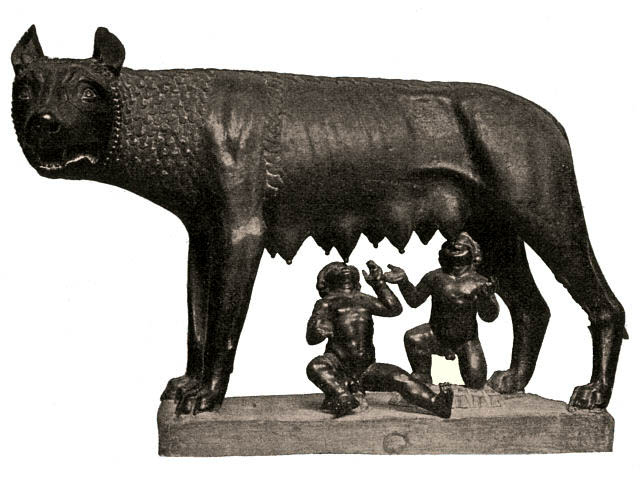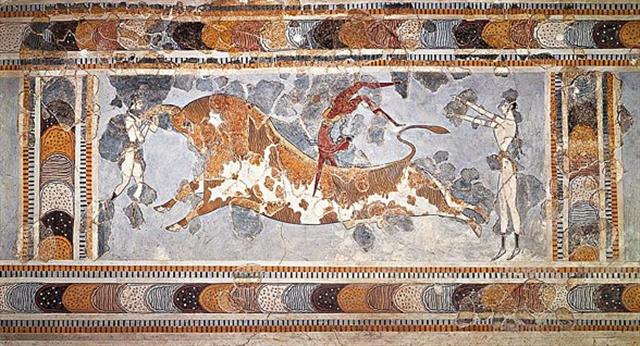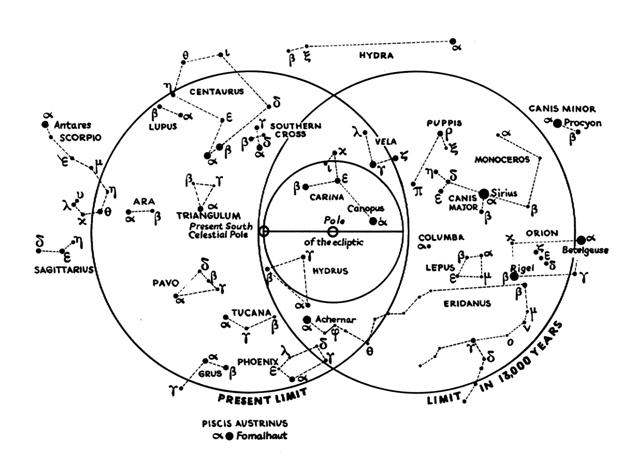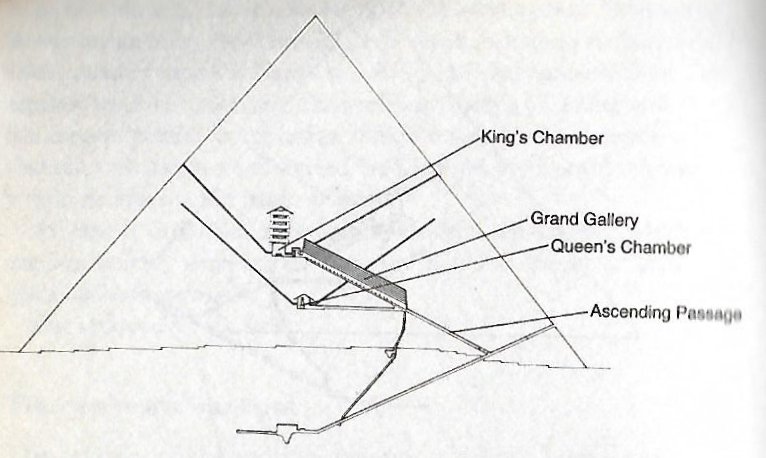262. This excursion emanated
from the insight that there were 16 glyphs
from the heliacal Khufu-star Mintaka (*82) to Vega (*281)
close to the Full Moon. *281 - *183 - *82 =
*16.
... At the time of rongorongo
Vega was located in December 27 (361 = 19 *
19 = 9 * 29 + 84 + 16) and this was around 71 * 281.8 = 20000
years before her position at 0h. The creator
of the C text appears to have used another
point of origin, *281 - *265 = *16 days
later (and 20000 - 71 * 16 = 18864).
However, Mintaka (the first to rise star in
the Belt of Orion) was returning to
visibility when the Full Moon reached the
right ascension line defined from Vega. 402
(6 February) + 16 = 418 (2-22) ...
|
6 Febr (365 + 37) |
7 |
8 (404) |
9 (40) |
 |
 |
 |
 |
|
Cb10-9 (631) |
Cb10-10 → 100 |
Cb10-11 |
Cb10-12 (242 = 40 + 202) |
10²
(100) + 11² (121) + 12² (144)
= 365 = 631 - 266:
|
2 Febr (33) |
3 |
4 (400) |
5 (36) |
6 (136 + 266) |
7 |
8 (*324) |
|
132 |
133 |
400 - 266 |
500 - 365 |
136 |
137 |
*58 |
 |
 |
 |
 |
 |
 |
 |
|
Ca10-6 |
Ca10-7 |
Ca10-8 |
Ca10-9 |
Ca10-10 |
Ca10-11 (266) |
Ca10-12 |
|
Tupu te toromiro |
kua noho te vai |
te
moko |
te
marama |
te kava |
manu
rere |
te mauga tuu toga |
|
*78 (= 6 * 13) |
APRIL 5 (95) |
Elnath |
June 10 (161) |
Mintaka |
Alnilam |
Alnitak |
|
*261 (= 9 * 29) |
OCT 5 (278) |
6 |
Dec 10 (344) |
Shaula |
Ras Alhague |
Wolf Pair |
|
... Midsummer is the
flowering season of the
oak, which is the tree
of endurance and
triumph, and like the
ash is said to 'court
the lightning flash'.
Its roots are believed
to extend as deep
underground as its
branches rise in the air
- Virgil mentions this -
which makes it
emblematic of a god
whose law runs both in
Heaven and in the
Underworld ...
The month, which takes
its name from Juppiter
the oak-god, begins on
June 10th and ends of
July 7th.
Midway
comes St. John's Day,
June 24th, the day on
which the oak-king was
sacrificially burned
alive.
The Celtic year was
divided into two halves
with the second half
beginning in July,
apparently after a
seven-day wake, or
funeral feast, in the
oak-king's honour ... |
|
|
ka hahaú
hia
- ko te rima
kua oho |
ku hahaú - kua
ka te ahi i ruga |
e te hau e |
ka oho te
kihikihi o te henua |
|
PYRAMID OF KHUFU
MINTAKA (Belt) = δ Orionis,
υ Orionis (82.4), χ Aurigae
(82.5), ε Columbae (82.6) |
PYRAMID OF KHAFRE
Al Hak'ah-3 (White Spot) /
Mrigashīrsha-5 (Stag's Head) /
Turtle Head-20 (Monkey) /
Mas-tab-ba-tur-tur (Little
Twins)
ARNEB = α Leporis, Crab Nebula =
M1 Tauri
(83.0,
φ¹ Orionis
(83.1),
HEKA = λ Orionis,
Orion Nebula = M42
(83.2),
HATYSA = ι Orionis
(83.5),
φ² Orionis
(83.6),
ALNILAM (String of Pearls) =
ε
Orionis
(83.7) |
PYRAMID OF MENKAURE
Three Stars-21 (Gibbon) /
Shur-narkabti-sha-shūtū-6 (Star
in the Bull towards the south) /
ANA-IVA-9 (Pillar of exit)
HEAVENLY GATE = ζ Tauri,
ν
Columbae (84.0),
ω
Orionis
(84.2),
ALNITAK (Girdle) =
ζ
Orionis,
PHAKT (Phaet) = α Columbae
(84.7) |
ο Aurigae (85.8), γ Leporis
(85.9)
YANG MUN (α Lupi) |
|
June 11 |
12 (403 - 240) |
13 (164 = 84 + 80) |
14 |
|
Al Shaula-17
ALWAID (Mother Camels) = β
Draconis, MAASYM (Wrist) = λ
Herculis
(265.1),
SHAULA (Sting) = λ Scorpii
(265.3),
KUMA = ν Draconis
(265.6),
σ
Arae (265.9)
HAMAL
(α Arietis) |
RAS ALHAGUE = α Ophiuchi
(266.1),
SARGAS = θ Scorpii (266.3),
μ Ophiuchi, π Arae (266.5),
NAN
HAE (Southern Sea) = ξ Serpentis
(266.6), AL
DHĪLI (The Wolf) = ω Draconis,
ι Herculis (266.7) |
λ Arae (267.1),
GIRTAB (Seizer) = κ Scorpii,
ο Serpentis (267.6),
DSIBAN
(Wolf Pair)
= ψ
Draconis
(267.9) |
KELB ALRAI (Dog of the Shepherd)
= β Ophiuchi,
μ
Arae (268.1),
KEW
HO (Nine
Rivers) = μ Herculis
(268.6),
η
Pavonis (268.7),
APOLLYON
= ι Scorpii
(268.9) |
|
Dec 11 (345 = 84 + 261) |
12 (*26 + *240) |
13 |
14 |
|
... On February 9 the Chorti
Ah K'in, 'diviners', begin
the agricultural year. Both the
260-day cycle and the solar year
are used in setting dates for
religious and agricultural
ceremonies, especially when
those rituals fall at the same
time in both calendars. The
ceremony begins when the
diviners go to a sacred spring
where they choose five stones
with the proper shape and color.
These stones will mark the five
positions of the sacred
cosmogram created by the ritual.
When the stones are brought back
to the ceremonial house, two
diviners start the ritual by
placing the stones on a table in
a careful pattern that
reproduces the schematic of the
universe. At the same time,
helpers under the table replace
last year's diagram with the new
one. They believe that by
placing the cosmic diagram under
the base of God at the center of
the world they demonstrate that
God dominates the universe. The
priests place the stones in a
very particular order. First the
stone that corresponds to the
sun in the eastern, sunrise
position of summer solstice is
set down; then the stone
corresponding to the western,
sunset position of the same
solstice. This is followed by
stones representing the western,
sunset position of the winter
solstice, then its eastern,
sunrise position. Together these
four stones form a square. They
sit at the four corners of the
square just as we saw in the
Creation story from the Classic
period and in the Popol Vuh.
Finally, the center stone is
placed to form the ancient
five-point sign modern
researchers called the quincunx
...
 |

The foundation of Rome was
around 2600 years before the
time of rongorongo. |
|
"Seamen have called it [Mintaka]
the Golden Yard-arm;
tradesmen, the L, or
Ell, the Ell and
Yard, the Yard-stick,
and the Yard-wand, as
occupying
3°
between the outer stars, - the
Elwand of Gavin Douglas;
Catholics, Our Lady's Wand;
and the husbandmen of France and
along the Rhine, Râteau,
the Rake. In upper Germany it
has been the Three Mowers;
and it is often the Magi,
the Three Kings, the
Three Marys, or simply the
Three Stars ..." (Allen)
... 'Tell us a story!' said the
March Hare. 'Yes, please do!'
pleaded Alice. 'And be quick
about it', added the Hatter, 'or
you'll be asleep again before
it's done.' 'Once upon a time
there were three little
sisters', the Dormouse began in
a great hurry: 'and their names
were Elsie, Lacie, and Tillie;
and they lived at the bottom of
a well — '
 |
|
10 |
20 Febr |
21 |
22-2 (53) |
23 |
24 (420) |
|
... The leap day was introduced
as part of the Julian reform.
The day following the Terminalia
(February 23) was doubled,
forming the 'bis sextum -
literally 'double sixth', since
February 24 was 'the sixth day
before the Kalends of March'
using Roman inclusive counting
(March 1 was the 'first day').
Although exceptions exist, the
first day of the bis sextum
(February 24) was usually
regarded as the intercalated or
'bissextile' day since the third
century. February 29 came to be
regarded as the leap day when
the Roman system of numbering
days was replaced by sequential
numbering in the late Middle
Ages ...
 |
 |
 |
 |
 |
 |
|
Cb11-1 |
Cb11-2 (254) |
Cb11-3 (631 + 16) |
Cb11-4 (648) |
Cb11-5 |
|
Te kihikihi -
tagata
moe |
ki te ariki - te hokohuki |
ko te inoino -
te henua |
te inoino - te
henua |
te henua |
|
Dec 25 (176 + 183) |
26 (*280 = 7 * 40) |
27 (361) |
28 |
29 (363 = 420 - 57) |
|
16 Oct |
17 (*210 = 7 * 30) |
18 (291) |
19 |
20 (293 = 420 - 127) |
|
KAUS BOREALIS
=
Λacie Sagittarii
(279.3) |
ν
Pavonis (280.4), κ Cor. Austr.
(280.9) |
Abhijit-22 (Victorious)
θ
Cor. Austr. (281.0),
VEGA
= α Lyrae
(281.8) |
no star listed (282) |
ζ
Pavonis (283.4), λ Cor. Austr.
(283.6),
DOUBLE DOUBLE
= ε Lyrae
(283.7), ζ Lyrae (283.8) |
|
Moe.
To sleep, to lie at full length,
to dream, to brood, to place, to
cohabit; moe atu, to
leave off, to desist; moe atu
ra, to adjourn, to postpone;
moe hakahepo, to talk in
the deep; moe aherepo,
somnambulist, sleepwalker;
moe hakataha, to
sleep on the side; moe no,
to oversleep, concubinage;
moe tahae, to be a light
sleeper; moe tahaga,
a sleeper; moe vaeahatu,
moe hakaroa, to sleep
sprawling; rava moe, to
sleep sound; ariga moe ki
raro, to lie flat on the
ground; tae moe,
bachelor; hakamoe, to
brood, to fold the wings; to
reserve, to lay up; to struggle.
P Pau.: moe, sleep. Mgv.:
moe, sleep, to lie down,
coitus, to shut the eyes. Mq.:
moe, to sleep, to lie
down; haámoe, to set down
on the ground. Ta.: moe,
to sleep, to lie down. Moea
raruga, lying flat.
Moeaivi, thin. Mq.: ivi,
haáivi, id. Ta.: ivi,
id. Moega, mat. Pau.:
moehega, bed. Mgv.: moega,
a sleeping mat. Mq.: moena,
moeka, mat, floor cloth,
bed. Ta.: moea, bed.
Moemata, to sleep with the
eyes open; mea moemata,
phantom. Moemoea, a
dream, vision; tikeahaga
moemoea, apparition by
night. T Mgv., Mq., Ta.:
moemoea, dream. Churchill. Mgv. Moemoe,
to steal, to purloin at a food
distribution. Mq.: moemoe,
to seize, to grasp. Churchill.
Ta.: 1. Moemoe, ambush.
Ha.: moemoe, id. 2.
Moemoe, Phyllanthus simplex.
To.: mohemohe, a tree.
Churchill. Mq.: Moehu,
exiled, banished, prisoner of
war. Ma.: morehu, a
survivor. Churchill. |
|
... They tightly swathed the
broken body in linen bandages, and when they
performed over it the rites that thereafter
were to be continued in Egypt in the
ceremonial burial of kings, Isis fanned the
corpse with her wings and Osiris revived, to
become the ruler of the dead. He now sits
majestically in the underworld, in the Hall
of the Two Truths, assisted by forty-two
assessors, one from each of the principal
districts of Egypt; and there he judges the
souls of the dead. These confess before him,
and when their hearts have been weighed in a
balance against a feather, receive,
according to their lives, the reward of
virtue and the punishment of sin ...
 |
Probably the date when
Hun-Nal-Ye entered the top of the Tree
(5 February 3112 BC) was not day 31
(January) + 5 = 36
but day 366 + 31 (January) + 5 = 402, at
heliacal Mintaka (*82). June 11 (162) -
February 5 (36) = 126 (= 3 * 42 = 18 weeks)
and 402 + 126 = 528 = 2 * 264 = 11 * 48.
... the Palenque scribes repeated Creation
again and described it as 'it was made
visible, the image at Lying-down-Sky, the
First-Three-Stone-Place'. Then we learned
that five hundred and forty-two days later
(1.9.2 in the Maya system), Hun-Nal-Ye
'entered or became the sky' (och ta chan).
This 'entering' event occurred on February
5, 3112 BC ...
|
Itzam-Yeh defeated |
28 May, 3149 BC (148) |
|
First 3-stone place |
21 May, 3114 BC (141) |
|
Creation of our present
world |
13 Aug, 3114 BC (225) |
|
Hun-Nal-Ye became the
sky |
5 Febr, 3112 BC (402) |
|
(3149 - 3112) / 71 =
0.52 < (26.6 - 26) |
|
21 May, 3114 BC - 13
August, 3114 BC = 225 -
141 = 84 (= 12 * 7)
21 May, 3114 BC - 5
February, 3112 BC = 542,
which 'happens to be'
the sum of 365 days and
6 * 29½ nights. |
|
148 (May 28) - *70 = 78
(19 March) |
The Khufu pyramid was,
however, not oriented towards Vega but towards the
tail of Draco:
In the year 3112 BC the north
pole star was not Polaris but Thuban (α
Draconis) and Hun-Nal-Ye could have
referred to Khnum:
"Maker of things which are,
creator of what shall be, the beginning of
beings, father of fathers, and mother of
mothers." (Book of the Dead)
In a footnote Allen comments
on Thuban and at the same time mentioning the Southern
Cross:
"This passage, 4 feet by 3½
feet in diameter and 380 feet long [4 * 3½ *
380 = 20 * 266; before the alphabet there
were numbers], was directed northward to
this star, doubtless by design of the
builder, from a point deep below the present
base, at an inclination of 26°
17' to the horizon [90° - 26° = 64° = the
declination of Thuban]. At the time of its
building, perhaps four milleniums before our
era, the Southern Cross was entirely visible
to the savage Britons."
Allen draws attention to the
opposite pole which had the Southern Cross
with Acrux (α)
half a right ascension year away. *187
(heliacal Acrux) + *183 = *370 (which
'happens to be' half the number of glyphs on
the C tablet) and then *370 + *27
(precessional distance down to Roman times)
- *185 (autumn equinox) = *212 (heliacal
Thuban). I.e., autumn equinox (September 22,
265) + 27 = October 19 (292 = 4 * 73) =
October 15 + 4.
|
no glyph (day zero) |
 |
 |
 |
 |
388 |
| Ca1-1 |
Ca1-2 |
Ca1-3 |
Ca1-4 |
| koia |
ki te hoea (instrument for tattooing) |
ki te henua |
te rima te hau tea |
| March 21 (80) |
22 (*1) |
23 |
24 |
25 |
| Sept 20 (*183) |
21 |
Equinox |
23 (266) |
ACRUX (*187) |
 |
 |
 |
 |
 |
| Cb1-1 (3 + 390) |
Cb1-2 |
Cb1-3 |
Cb1-4 (396) |
| E tupu - ki roto |
o te hau tea |
ki te henua - te maro |
| Oct 17 (290) |
18 |
THUBAN (*212) |
20 |
| April 17 (107) |
18 |
19 (*29) |
20 |
| 'March 21 (290 - 210) |
22 |
23 (*2 = *29 - *27) |
24 |
| 'Sept 20 (*183) |
21 |
Equinox |
23 (266) |
 |
As
it
was
explained
on
Hawaii:
...
The
first
line
is
drawn
from
Hoku-paa,
the
fixed
or
North
Star,
to
the
most
southerly
star
of
Newe,
the
Southern
Cross
...
Polaris
was
at
the
last
glyph
on
side
a
and
from
Acrux
to
Polaris
there
were
*187
(heliacal
Acrux)
+
*183
=
*370
(which
'happens
to
be'
half
the
number
of
glyphs
on
the
C
tablet)
and
then
*370
+
*26
(Polaris)
=
*396.
|
Counting the tresses of Pachamama (the World Mother) from right to left: |
|
1 |
26 |
78 |
1 |
29 |
90 |
|
2 |
26 |
2 |
30 |
|
3 |
26 |
3 |
31 |
|
4 |
25 |
104 |
4 |
34 |
124 |
|
5 |
26 |
5 |
31 |
|
6 |
27 |
6 |
30 |
|
7 |
26 |
7 |
29 |
| 182 (= 7 * 26) |
214 (= 2 * 107) |
|
Total = 396 = 182 + 214 = 364 + 32 |

|





















